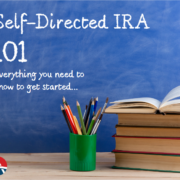Deductible Vs. Non-Deductible Self-Directed IRA Contributions
For most middle-class Americans, much of the value of the traditional IRA, including the traditional Self-Directed IRA, lies in the pre-tax contribution. Essentially, this means an effective tax deduction of up to $5,500 per year, or up to $6,500 per year for those over age 50, thanks to catch-up contributions. This provides a nice reduction in tax liability for the current year.
But not everyone can qualify to deduct the full allowable Self-Directed IRA contribution. As income increases, the allowable deduction you can take to contribute to a traditional IRA gradually decreases.
But the total allowable contribution to the traditional IRA or Self-Directed IRA remains the same, regardless of your income. It may make good sense to continue to contribute as much as possible to a traditional IRA, even on a non-deductible basis. This is especially true if you earn too much money to contribute to a self-directed Roth IRA.
Here’s why:
Even though you may not receive a deduction for your full current year contribution to a traditional IRA or Self-Directed IRA, the IRA structure still provides a number of important advantages:
Taxes
First, money held in a traditional IRA grows tax-deferred for as long as you hold it in your account. It is not subject to federal income taxes on interest, nor dividend taxes, nor capital gains taxes. This is true no matter how many times you may buy or sell your Self-Directed IRA assets. You are not obligated to pay any federal taxes on your own money invested within a Self-Directed IRA.
Exception: A special tax, called unrelated business income tax, may apply if you have borrowed money within your IRA. You can be charged income tax on profits, income or growth attributable to leverage, even within your IRA or Self-Directed IRA.
Non-Deductible Self-Directed IRAs vs. Annuities
Generally, non-deductible IRA contributions have very similar tax advantages to annuities: There’s no upfront tax deduction. But taxes are deferred as the account grows over time. Income is taxable, but your non-deductible contributions are counted toward your tax basis in your IRA account, reducing your tax liability later.
Filing
When you make a non-deductible contribution to a traditional IRA or traditional Self-Directed IRA, you should file an IRS Form 8606 along with your tax return for the year in which you made the contribution. Note that you have until April 15th of the following year, or the tax filing deadline if it falls after April 15th, to make non-deductible contributions to a traditional IRA or traditional Self-Directed IRA.
Assets in an IRA enjoy substantial protection from creditors, and are generally considered exempt from creditor seizure in the event of bankruptcy.
When to use a Non-Deductible IRA
The non-deductible IRA option isn’t ideal: Most people would rather make a traditional deductible contribution, or contribute to a Roth IRA. But if you make too much to be eligible for a Roth IRA, and you want to contribute more assets to a Self-Directed IRA because you don’t have access to other Self-Directed IRA options, such as a 401(k), or you’ve already maximized your contributions to other retirement accounts, then the non-deductible IRA option may come in handy.
Of course, you can also consider an annuity – which has many advantages to recommend it. However, you cannot self-direct assets in an annuity like you can self-direct assets in a non-deductible IRA. You can’t direct annuity assets to invest in real estate properties that you control and you’ve selected yourself.
The IRA structure also provides more hardship provisions in case you want to make a withdrawal prior to age 59½, such as the ability to make a penalty-free withdrawal to help fund college education for a family member or fund a down payment for a home or pay medical expenses.
In many cases, the IRA has lower fees than annuities or other investment options. Contact American IRA, LLC today to learn how our flat-rate menu can save investors thousands in fees.
The non-deductible option may also come in handy if you don’t have access to a workplace retirement plan but your spouse does.
For those planning ahead, a contribution to a non-deductible IRA may help get them into a position to convert more assets into a Roth IRA down the road.





